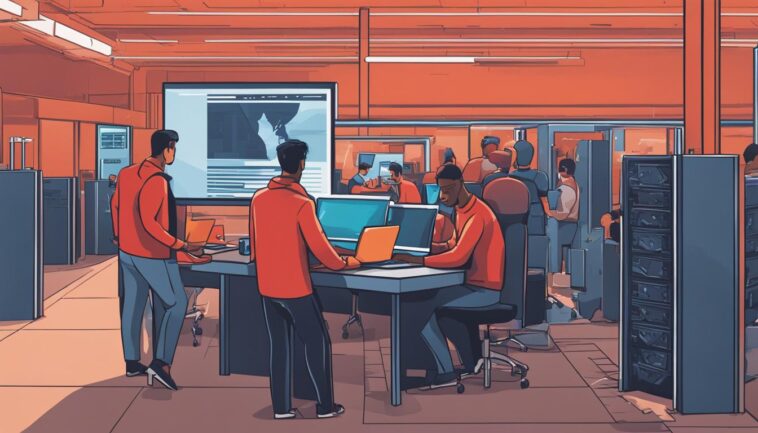The landscape of the American workforce has evolved dramatically, with remote work solidifying as a cornerstone of modern employment. This flexibility, while beneficial in many respects, has broadened the cybersecurity battleground. Cybersecurity measures have become quintessential for organizations with telecommuting contingents to protect against evolving threats. As working from home becomes more prevalent, organizations must prioritize remote access security and fortify endpoint security to shield sensitive data from cybercriminals.
With remote positions constituting a significant proportion of the job market, the urgency to implement robust work from home security protocols is at an all-time high. Bolstering cybersecurity infrastructures to safeguard remote operations underscore the proactive approach organizations are taking in response to a surge in reported cyberattacks targeting remote workers.
Cybersecurity teams are adapting at a breakneck pace, deploying an arsenal of security measures designed to mitigate the risks associated with the decentralized nature of a telecommuting workforce. Key among these defenses are heightened endpoint security practices and stringent remote access security measures, ensuring that only authorized personnel are navigating the corporate network from afar.
Key Takeaways
- Amplification of Remote Work necessitates robust cybersecurity measures to protect organizational data.
- Endpoint security is increasingly critical as employees operate outside traditional office perimeters.
- Telecommuting security now requires adapting to an expanded scope of cyber threats.
- Cybersecurity policies must evolve with the growing remote workforce to ensure comprehensive protection.
- It’s vital for organizations to integrate strong encryption and authentication protocols for remote access points.
Understanding the Cybersecurity Implications of Telecommuting
The shift toward telecommuting has undoubtedly introduced a myriad of security challenges and complications. As organizations strive to accommodate remote work policies, their cybersecurity infrastructures are stretched thin, contending with an increasingly dispersed workforce. It’s paramount that businesses recognize the variety of threats this new era of work poses, among which are amplified attack surfaces, more potent cyberattack threats, and tougher regulatory compliance challenges.
The Expansion of Attack Surfaces with Telecommuting
With employees working remotely, the traditional boundaries of an organization’s network have blurred, dramatically increasing the attack surfaces of potential cyber threats. Telecommuting security now has to account for a raft of additional endpoint devices and networking connections, each presenting a potential entry point for malicious actors. Hoodwinking overworked IT departments becomes considerably easier when workers are dispersed across various, often insufficiently secured, networks.
The abundance of devices and the inherently less secure nature of home networks compound the problem, leading to a significant rise in data breaches as cybercriminals exploit these new vulnerabilities. These vulnerabilities are exacerbated further by the integration of personal and professional devices, making it harder to maintain secure network perimeters.
Data Regulation Compliance in a Remote Work Setting
Ensuring regulatory compliance becomes increasingly complex as well. Data privacy and protection laws necessitate careful handling of information, but when an employee works remotely, data could inadvertently be processed in jurisdictions with conflicting laws. Organizations could thus find themselves on the wrong side of legal requirements, facing hefty fines and damaged reputations.
In addition to the risk of legal repercussions, companies must consider the implications of insufficient compliance measures on their customer trust and consequently, their market share—as consumers become progressively more privacy-conscious.
Case Study: Rising Number of Cyberattacks Post-Pandemic
A troubling trend has emerged since the onset of the pandemic: a surge in the frequency and sophistication of cyberattack threats. Phishing and social engineering attacks, a perennial threat, have become even more successful against remote employees who may be more distracted or isolated than in an office setting.
Today’s cybercriminals are also leveraging AI in their attacks, capitalizing on workers less attuned to the nuances of their colleagues’ digital communication styles. This makes remote workers particularly susceptible, as they are often cut off from the informal security checks provided by office environments. What complicates matters further is the use of shared networks that mingle both private and professional devices, further diluting the secure perimeter and trebling the chances for successful exploits.
Through adaptability and rigorous cybersecurity practices, however, companies can strive to mitigate these new-age threats and safeguard the sanctity of their informational assets as they navigate the post-pandemic landscape of telecommuting.
Fortifying Endpoint Security for Remote Access
As companies adapt to the increasing necessity for secure remote network access, endpoint security has become a focal point for IT departments. To operate effectively in the modern work-from-home era, the implementation of cybersecurity policies that encompass a range of protective tools and practices is critical. Businesses are rapidly integrating technological solutions like cloud platforms, virtual private networks (VPN), and password managers to ensure that their workforces can maintain encrypted communications and safeguard sensitive company data.

One clear trend is the implementation of Virtual Private Networks (VPNs), which are essential for work from home security. With a simple one-click activation, VPNs provide a secure channel for remote employees to access corporate resources. Likewise, multi-factor authentication tools, including two-factor authentication (2FA) protocols and single sign-on (SSO) systems, have become standard practice, offering an additional layer of security to the remote access infrastructure.
| Security Tool | Function | Benefit to Remote Work Security |
|---|---|---|
| Cloud Platforms | Data storage and application support | Centralizes resources for easy and secure remote access |
| Virtual Private Networks (VPNs) | Creates a secure, encrypted connection to the network | Ensures encrypted communications and secure data transmission |
| Single Sign-On (SSO) | Unified authentication for multiple services | Simplifies log-in processes while maintaining strong access controls |
| Password Managers | Secure storage and retrieval of complex passwords | Reduces risk of password-related breaches |
| Two-Factor Authentication (2FA) | An additional layer of security beyond passwords | Prevents unauthorized access even if passwords are compromised |
Moreover, in ensuring robust endpoint security, it’s not uncommon for businesses to adopt specialized tools such as GoSilent Cubes by Archon, specifically designed with remote work in mind. These comprehensive security suites are critical in protecting the data exchange between remote devices and corporate networks, shielding businesses from potential cyber intrusions and elevating encrypted communications to the highest standard.
Ultimately, while technology plays a significant role in securing endpoints, the formation and enforcement of comprehensive cybersecurity policies cannot be understated. These policies guide behavior and set forth the expectations for security practices, ensuring that employees remain vigilant and informed about the best ways to protect corporate data and maintain a secure remote network access environment.
Best Practices for VPN Security and Network Protection
For professionals navigating the complexities of Cybersecurity work from home threats, understanding and implementing best practices for VPN security and home Wi-Fi safety is essential. These measures ensure that the transition to remote work is not only smooth but also secure, guarding sensitive data against cyber threats.
Implementing Multi-Factor Authentication for VPN Access
One significant way to enhance VPN security is through Multi-factor authentication (MFA). MFA ensures that user identity is verified through multiple methods, greatly reducing the likelihood of unauthorized access.
Teaching Remote Workers to Secure Their Home Networks
Remote employees play a critical role in maintaining Home Wi-Fi security. By training workers in secure network configuration, organizations can substantially increase their resilience to cyberattacks. Here are essential steps for a more secure home network:
- Change default router passwords to strong, unique alternatives.
- Enable WPA2 or WPA3 encryption to protect the network.
- Limit access by using MAC filtering to recognize only specific devices.
- Update router firmware regularly to patch vulnerabilities.
| Security Feature | Benefit | Implementation Tip |
|---|---|---|
| Multi-Factor Authentication | Reduces risk of compromised passwords granting access. | Employ at least two methods; something the user knows, and something the user has. |
| WPA2/WPA3 Encryption | Protects data as it travels between devices and the router. | Select the highest level of encryption available in your router’s settings. |
| MAC Address Filtering | Provides an additional layer by limiting device connections. | Allow only devices that require network access and are fully trusted. |
| Firmware Updates | Keeps router defenses up-to-date against emerging threats. | Set a schedule to check for and install any firmware updates from the manufacturer. |
By adhering to these guidelines, both businesses and their employees will fortify their defenses against Cybersecurity work from home threats, making remote work a safer proposition for all involved.
Remote Work and the Use of Secure Collaboration Tools
Within the digital workspace, the significance of secure collaboration tools cannot be overstated, especially as companies worldwide continue to navigate the complexities of telecommuting. As the physical boundaries of offices give way to virtual environments, the necessity for digital workspace security has surged. This shift demands platforms that not only facilitate communication and productivity but also maintain strict cybersecurity measures to protect sensitive data. In this light, the use of platforms offering end-to-end encryption is not merely an option but a vital requirement for businesses to stay ahead of cyber threats in a remote access security landscape transformed by remote work.
Instances of unauthorized access and disruptions, such as the infamous “Zoombombing,” have prompted federal agencies, including the FBI, to call for heightened vigilance with video conferencing software. Features like background obfuscation enhance privacy, forestalling the accidental leakage of critical information. Beyond video calls, effective telecommuting security rests on consistent implementation of two-factor authentication and single sign-on functionalities. Such practices, along with the deployment of password managers, are rapidly becoming the bedrock of secure login protocols. They are foundational components not to be overlooked in the broader fabric of remote work policies.
Further fortifying the perimeter, SaaS applications equipped with security management features offer real-time oversight of users’ network activities and access permissions. This proactive approach to digital workspace security is instrumental in preempting potential breaches and maintaining unwavering vigilance against cyber threats. As remote work cements itself into the corporate structure, leveraging cybersecurity measures that support robust and resilient SaaS-based technologies is crucial to safeguarding the integrity and continuity of businesses operating in the digital age.


